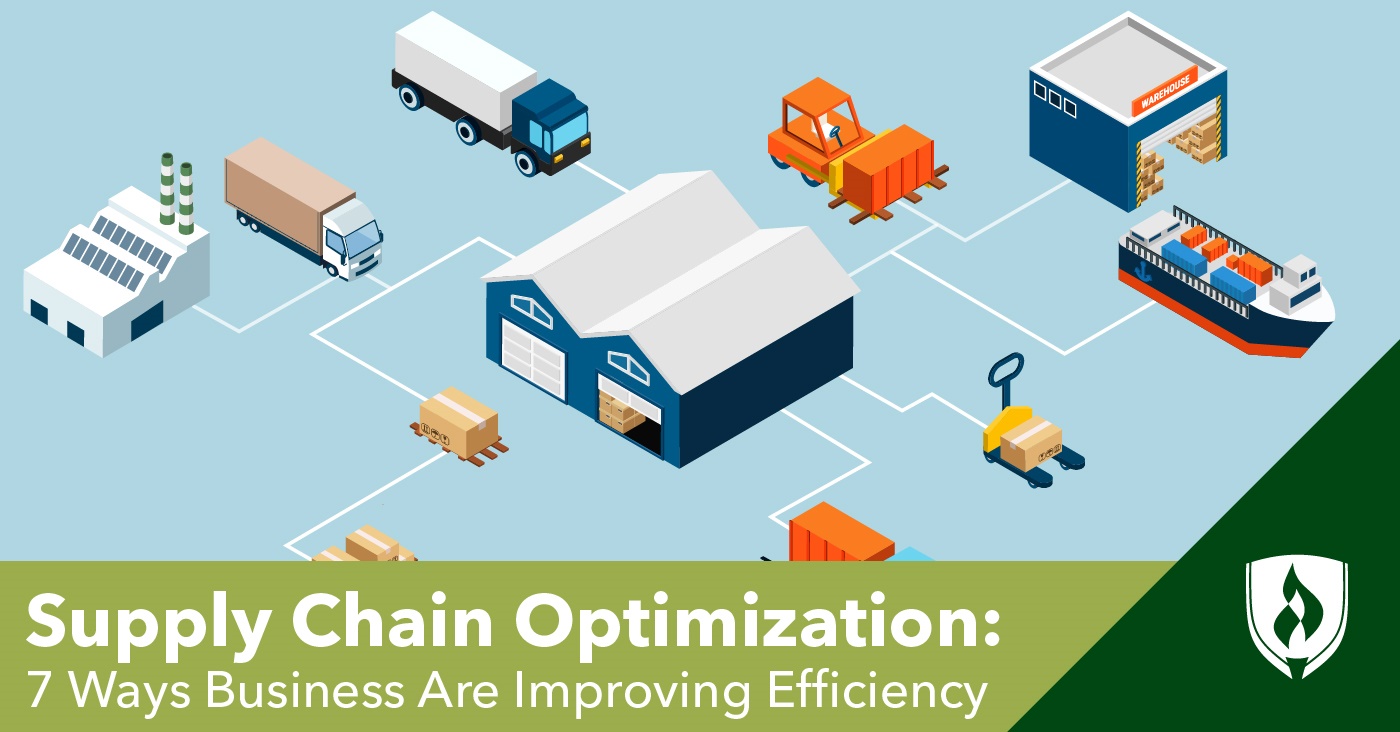Supply Chain Optimization: 7 Ways Businesses Are Improving Efficiency
By Ashley Brooks on 05/31/2021

A supply chain is one of those things most people don’t think about—as long as it’s operating the way it’s supposed to. But as soon as there’s a kink in the supply chain that causes people to have lack of access to supplies, like food or gas, for example, it becomes obvious just how important this aspect of the business world really is.
Supply chain professionals are working on a daily basis to improve supply chain optimization so that issues like this don’t happen. What exactly does that look like? We spoke with experts to find out.
Join us as we learn more about how the supply chain works, the steps businesses are taking to improve supply chain efficiency and the impact their work has on the supply chains we all rely on.
How does the supply chain work?
“Put simply, the supply chain is a series of events and activities that lead to the delivery of goods or services to the consumer,” says Stacey O’Neill, logistics expert with Nationwide Courier Service.
Although it sounds simple to take a product and move it from point A to point Z, there are many components to the supply chain, each with its own moving parts that need to be managed. “That means that everything from the creation of raw materials to manufacturing and even transportation to your local shop is all a pivotal part of the supply chain,” O’Neill says.
Supply chain professionals oversee this process to make sure that enough products are available, manage and distribute inventory, supervise warehouse operations, and arrange for the proper packaging and shipping of goods.
7 Ways businesses are improving supply chain optimization
As you can see, working in the supply chain involves collaboration between many different teams of specialists who each focus on a particular area. The more efficient businesses can make their supply chains, the more money they can save for themselves and customers and the better customer service they can offer.
This may seem like something that only affects businesses, but the supply chain is vitally important to individuals as well. “Your action can have an effect on businesses’ and people’s futures down the chain. This means that you could be having an effect on someone’s main source of income, their livelihood and even their happiness,” O’Neill says.
With so much at stake, it’s no wonder that businesses in all types of industries are focusing on optimizing their supply chains. These are some of the tactics they’re using to do just that.
1. Automation
Automating recurring tasks is a major driver of efficiency in the supply chain because it frees up employees to focus on other tasks that require more creative problem-solving skills than artificial intelligence (AI) technology can currently offer.
“By implementing automation within your supply chain, you'll spend much less time trying to organize and keep track of everything,” O’Neill says. Examples of supply chain automation include tracking product stock or supplies to automatically order more before you run out, automatically updating customers about shipping times, and tracking warehouse inventory.
2. Supply chain mapping
Many different organizations are involved in a single supply chain, from the vendors who supply the raw materials needed to manufacture a product to the shipping carriers who will eventually deliver products to retailers or customers. It can be easy to lose track of who exactly your suppliers are, especially if you’re part of a large organization or a company that manufactures many different products.
That’s where supply chain mapping comes in. Supply chain pros use specialized software to better visualize their products’ supply chains. This can help them make strategic decisions, like choosing to search for more affordable vendors, or perform risk analysis, such as noticing that severe weather is expected to impact the location of a key supplier.
3. Supply chain audits
Some organizations take supply chain mapping a step further and conduct audits. Internal supply chain managers or outside consultants review every step of the supply chain, searching for areas where efficiency could be improved, prices could be cut, data security could be tightened or contracts could be renegotiated.
These audits can also help businesses learn more about the suppliers their vendors use in their supply chains. This is essential for organizations that have values-driven goals, such as ensuring ethical wages for all the workers in their supply chain or achieving certain environmentally friendly milestones in their production process.
4. Inventory optimization
“Inventory optimization involves using statistical techniques to calculate the minimum amount of inventory required to fulfill customer orders at a desired service level,” says David Altemir, president of supply chain management consulting company Altemir Consulting.
Altemir notes that this is one area where many manufacturing companies could step up their game. Because it costs money to hold onto inventory, the goal is to keep inventory levels as low as possible without running into supply problems when customers place orders. Inventory optimization can help organizations save money that could be redirected toward developing new products or to lower prices for the end consumer.
5. Analytics tracking
Most businesses have seasonal ups and downs, which can affect the supply chain. No one wants to run out of stock during busy seasons or have too much money tied up in inventory that no one is ordering during slower times.
Instead of guessing about how many raw materials to order or products to produce, the most efficient businesses rely on analytics to help them make supply chain decisions. “Looking at your previous year's sales and taking into account the current and recent trends will give you a good understanding of what you should expect,” O’Neill says.
6. Lean material management
Lean manufacturing is an idea that’s been around since the early days of Ford® and Toyota® manufacturing; it’s stood the test of time. Altemir shares that lean material management “uses a number of techniques” to “more efficiently balance supply and demand between a supplier and a consumer at any point in a supply chain.”
This best practice of supply chain management includes focusing on topics like the overall flow of products throughout a warehouse, defining the value of lean management for the organization and the Japanese principle of Kaizen , or continuous improvement.
7. Vendor management
This supply chain management tactic comes down to one simple principle: prioritizing relationships. Where many of the other strategies on this list have focused on technology or analytics, vendor management is all about using strong communication and negotiation skills to develop loyalty with vendors.
By using preferred vendors year after year and negotiating contracts that are beneficial to both parties, businesses can ensure that their supply chains continue flowing smoothly without lack of access to materials. Successful vendor management can result in lower prices, preferred access to materials that may be in short supply and decreased risk that a vendor will fail to come through on an order.
Could you be part of the supply chain solution?
There’s more to the supply chain than meets the eye. It’s not a small undertaking to keep the world’s economy moving—and on time. If you’re fascinated by these tactics of supply chain optimization, you may want to consider pursuing a career in supply chain management. Check out our article " 7 Data Innovations That Are Advancing Industries of All Kinds".
Wondering what types of careers are available to supply chain professionals? Find out with our article “ What Can You Do with a Supply Chain Management Degree? 9 Careers to Consider.”
Related Articles:
- What Are the World’s Busiest Ports? And Other Logistics Questions Answered
- What Is a Logistics Manager? Exploring This Under-the-Radar Supply Chain Role
Ford is a registered trademark of Ford Motor Company, Inc.
Toyota is a registered trademark of Toyota Motor Corporation.




